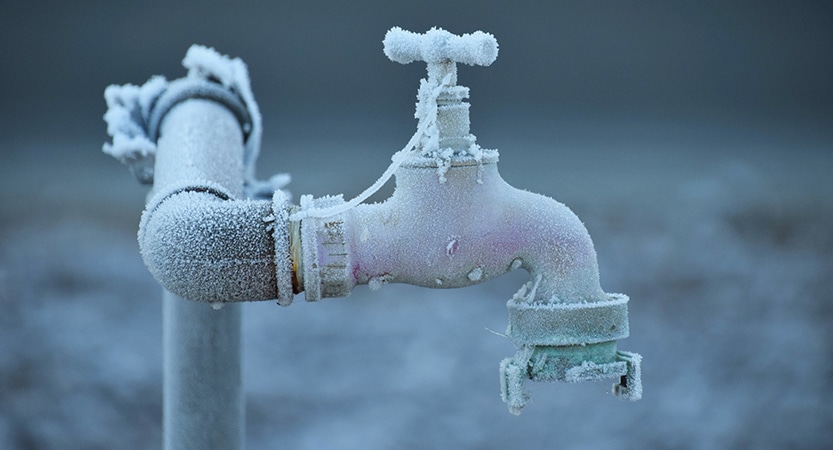Here underneath you will discover lots of incredibly good resources when it comes to Helpful Tips to Prevent Frozen Pipes this Winter.

Cold weather can ruin your pipes, especially by freezing pipes. Here's how to prevent it from taking place and what to do if it does.
Intro
As temperature levels decrease, the risk of frozen pipes rises, possibly resulting in costly fixings and water damages. Understanding just how to avoid icy pipes is crucial for house owners in cold climates.
Avoidance Tips
Shielding susceptible pipelines
Cover pipelines in insulation sleeves or use heat tape to secure them from freezing temperature levels. Concentrate on pipelines in unheated or exterior areas of the home.
Heating techniques
Keep interior spaces sufficiently heated up, particularly locations with pipes. Open up closet doors to permit cozy air to distribute around pipelines under sinks.
Exactly how to identify frozen pipelines
Seek lowered water circulation from faucets, uncommon odors or noises from pipelines, and noticeable frost on subjected pipelines.
Long-Term Solutions
Architectural modifications
Think about rerouting pipelines away from exterior walls or unheated areas. Add additional insulation to attic rooms, basements, and crawl spaces.
Upgrading insulation
Invest in high-grade insulation for pipelines, attic rooms, and wall surfaces. Appropriate insulation helps keep constant temperatures and minimizes the danger of icy pipelines.
Safeguarding Exterior Pipes
Garden pipes and exterior faucets
Separate and drain yard tubes before winter. Install frost-proof spigots or cover outside faucets with shielded caps.
Comprehending Icy Pipelines
What creates pipelines to freeze?
Pipes freeze when exposed to temperatures below 32 ° F (0 ° C) for prolonged periods. As water inside the pipelines freezes, it broadens, taxing the pipeline wall surfaces and potentially creating them to rupture.
Threats and problems
Frozen pipelines can cause supply of water disruptions, residential or commercial property damages, and costly repairs. Ruptured pipes can flooding homes and cause considerable structural damage.
Signs of Frozen Pipes
Determining icy pipes early can stop them from breaking.
What to Do If Your Pipelines Freeze
Immediate actions to take
If you suspect icy pipes, keep taps open to soothe stress as the ice melts. Utilize a hairdryer or towels soaked in hot water to thaw pipes slowly.
Verdict
Protecting against icy pipes needs positive measures and fast responses. By comprehending the reasons, indicators, and preventive measures, house owners can safeguard their pipes during cold weather.
5 Ways to Prevent Frozen Pipes
Drain Outdoor Faucets and Disconnect Hoses
First, close the shut-off valve that controls the flow of water in the pipe to your outdoor faucet. Then, head outside to disconnect and drain your hose and open the outdoor faucet to allow the water to completely drain out of the line. Turn off the faucet when done. Finally, head back to the shut-off valve and drain the remaining water inside the pipe into a bucket or container. Additionally, if you have a home irrigation system, you should consider hiring an expert to clear the system of water each year.
Insulate Pipes
One of the best and most cost-effective methods for preventing frozen water pipes is to wrap your pipes with insulation. This is especially important for areas in your home that aren’t exposed to heat, such as an attic. We suggest using foam sleeves, which can typically be found at your local hardware store.
Keep Heat Running at 65
Your pipes are located inside your walls, and the temperature there is much colder than the rest of the house. To prevent your pipes from freezing, The Insurance Information Institute suggests that you keep your home heated to at least 65 degrees, even when traveling. You may want to invest in smart devices that can keep an eye on the temperature in your home while you’re away.
Leave Water Dripping
Moving water — even a small trickle — can prevent ice from forming inside your pipes. When freezing temps are imminent, start a drip of water from all faucets that serve exposed pipes. Leaving a few faucets running will also help relieve pressure inside the pipes and help prevent a rupture if the water inside freezes.
Open Cupboard Doors
Warm your kitchen and bathroom pipes by opening cupboards and vanities. You should also leave your interior doors ajar to help warm air circulate evenly throughout your home.

Hopefully you enjoyed our part on Winter Plumbing Precautions: Preventing Frozen Pipes. Thank you for taking a few minutes to browse our blog. Appreciated our piece of writing? Please quickly share it. Let someone else discover it. I am grateful for your time. Kindly come visit our blog back soon.
This Website